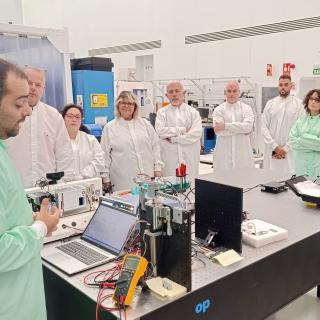The European Week of Astronomy and Space Science EWASS 2015 has been the largest of these conferences held so far. “The number of participants was just short of 1,200, almost twice as many as in previous editions. It has been a success in this sense, and we think that this is due, above all, to the quality and the diversity of the content” explains Cathie Clarke, co-chair of the Scientific Organizing Committee. The other co-chair, who is a researcher at the Institute of Astrophysics of the Canaries (IAC), Johan Knapen, stressed that in the 40 parallel sessions “there have been in all, over 700 oral presentations, and more than 300 posters, and people have been able to make many contacts with colleagues in other countries”.
This is, in fact, one of the main objectives of these European conferences. “Our goal is to unite the European astronomical community, and we are very happy because this extremely well attended conference has enabled us to do just that” says the President of the European Astronomical Society, Thierry Courvoisier, who participated in the closing ceremony, along with the Secretary of State for Research, Development, and Innovation of the Ministry of Economics and Competitivity, Carmen Vela del Olmo. The Secretary of State thanked all the participants for their presence, emphasized the high level of Spanish astronomy, and pointed out the coincidence of the conference with the celebration of the 30th anniversary of the Canary Island Observatories.
EWASS 2015 was celebrated from June 22nd to 26th on the Guajara Campus of the University of La Laguna. ULL, (Tenerife), coordinated locally by the Institute of Astrophysics of the Canaries (IAC) and organized by the European Astronomical Society (EAS) in collaboration with the Spanish Astronomical Society (SEA), the IAC, and the ULL
Diversity of topics and a black hole
The organizers coincide in pointing out the great variety of topics which were covered in the 40 parallel sessions, from cosmology, the Solar System, stars, galaxies, …and including instrumentation and astronomical outreach.
One of the most outstanding themes has clearly been that of the observations, still under way, of the awakening of the black hole known as V404, which is consuming mass from its neighbouring star, and for which the observations in the visible have been led by the Gran Telescopio CANARIAS (GTC). (More information in the press release of June 25th).
Great interest was also aroused by the plenary lecture by Mark Bentley, of the Institute of Space Research (Austria) about the Rosetta Mission of the European Space Agency (ESA), which is being extended until September 2016. He commented that ice had been discovered on the surface of the comet, and that the area where the module Philae (which woke up very recently after a dormant period in the shadow) landed, seemed to offer favourable conditions. "All we need now," he said "is a stable connection between the robot and Rosetta, in orbit around the comet". As the comment approaches perihelion, the point of its orbit nearest to the Sun, it will give Philae more hours of light to charge its batteries and to observe the increase in the comet's activity".
60% women in the plenary lectures and the EAS prizes
A large number of younger researchers have attended this EWASS. “We have made a big effort to attract them to this conference, and we have succeeded: there are some 250 doctoral or master’s degree students, a much higher figure than in previous EWASS meetings,” said Johan Knapen.
The high proportion of women is also a notable feature, and not only among the general attendance at the conference: three of the five plenary lectures and three of the five high level prizes awarded during the meeting by the EAS were given to women, this is 60% in both cases. “We chose the researchers who seemed most interesting to us” explains Thierry Courvoisier “and it turned out that this resulted in a large presence of women on the program” Cathie Clarke added “ This is a natural consequence of the fact that there are many women making important advances in European astronomy at the moment”.
A milestone for Spanish astronomy
Of the 1,200 participants more tan 300 are Spanish, which gives an idea of the potential for astronomy in our country. Javier Gorgas, President of the Spanish Astronomical Society had no hesitation in stating that “This conference marks a milestone for Spanish astronomy, it is the largest astronomical conference which has ever been held in our country”. It has been an opportunity, therefore “to show that Spain is a major player in astronomy, and that we have researchers in the front line in almost every field of this science”.



